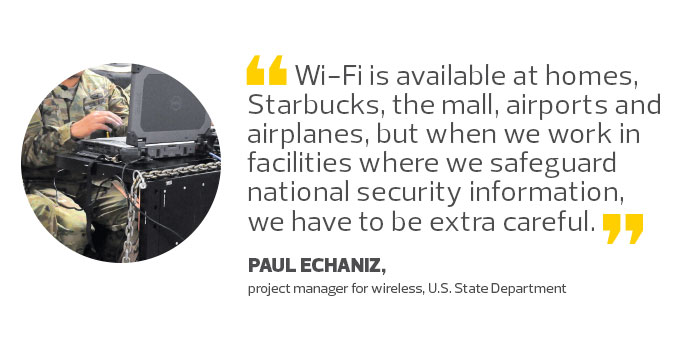DOD, Other Agencies Ready Wi-Fi Networks to Maximize Mobile Opportunities
Early this year, IT staff at the Department of Defense began installing wireless access points throughout the Pentagon, a building notorious for poor cellphone and wireless Internet reception.
While the access points were placed only in the E ring, the Pentagon’s outmost layer of offices, the investment in wireless infrastructure signified a larger trend: Mobile workers are becoming more demanding in their use of wireless devices. That’s true even in one of the world’s most secure buildings.
David DeVries, the Defense Department’s principal deputy CIO, says the number of users connecting to the wireless network is still low, but that will soon change. He highlights himself as a test case.
“With wireless access points, I can work on something in my office and take the tablet to an unclassified meeting and continue to access data and resources,” he says. “When I walk now from one side of the Pentagon to the other, my BlackBerry picks up the wireless signal and allows me to continue to work. Before, the building blocked my carrier’s connection, but now the wireless takes over.”
While technologies such as mobile device management and access points get attention, organizations must bolster every part of their network to prepare for this growth in devices. That includes providing increased user bandwidth, faster connection speeds, robust network security and mobile governance procedures and policies.

Agency IT leaders must also future-proof networks, ensuring what is built today can handle the continued growth of mobile over the next five to 10 years.
DeVries and other Pentagon IT leaders have a firm understanding of this advancing trend. As of May, the Pentagon had approximately 200 wireless access points installed, with plans to expand to 450 by the end of the year. Plans also exist to push wireless access into other parts of the building, although not into classified areas where mobile devices are prohibited.
DeVries says each access point can comfortably accommodate 30 users. When the program finishes, nearly half of the Pentagon’s approximately 27,000 employees can connect at once.
The wireless push goes beyond the Pentagon. DeVries says the Defense Department wants to put wireless access in other buildings across the country.
It is more cost-effective, DeVries notes, to install access points and connect desktop computers to wireless instead of fiber-optic cables. That’s especially true in military hospitals.
“In our hospitals, we have guest internet for patients. And more and more, we find doctors and nurses would rather connect to the wireless network,” DeVries says. As a whole, government lags behind industry in wireless adoption. That’s doubly true for departments such as DOD that store classified, or otherwise sensitive, information.
A number of agency IT leaders, though, find themselves fortifying their existing mobile infrastructure as mobile technology grows, or in some cases, investing for the first time. This investment is necessary as the management, productivity and cost benefits of wireless connectivity have become impossible to ignore.
In a blog post earlier this year, Mary Davie, an assistant commissioner with the General Services Administration, said the use of federal contracting tools for wireless services jumped 500 percent from fiscal year 2014 to 2015.
“This increase is due to greater demand for better management and savings, as agencies integrate mobile technology into their IT enterprise,” Davie wrote. “It’s also due to agencies transforming their work environments with more mobile and flexible options.”
Overcoming Security Concerns
“The federal government was slow to adopt wireless because of security reasons, but in the last year, adoption has kicked in as security improved,” says Dan Kent, U.S. public sector chief technology officer for Cisco Systems.
Kent says civilian agencies appear more advanced than the Defense Department, but both remain far short of the commercial sector.
Paul Echaniz, a project manager for wireless at the Department of State, says security concerns long prevented wireless connectivity in many overseas embassies. With technologies such as identity and access management, as well as location-based access systems, the State Department recently launched a wireless program.

SOURCE: Citrix Systems, “7 Enterprise Mobility Statistics You Should Know,” June 2015
“This will help untether users from their desk and serve as a medium for cloud services,” Echaniz says. “Wi-Fi is available at homes, Starbucks, the mall, airports and airplanes, but when we work in facilities where we safeguard national security information, we have to be extra careful.”
For security reasons, Echaniz is reluctant to speak about specific challenges and solutions. Kent, however, says the emergence of the National Security Administration’s Commercial Solutions for Classified Program helps previously skittish agencies begin mobile adoption.
Over the past several years, the Securities and Exchange Commission gradually rolled out mobile devices and infrastructure. Today, the agency features more than 600 wireless access points at its headquarters and regional offices, says Pamela Dyson, the agency’s CIO. “People can carry their notebooks into meetings. It really allows for more integrated collaboration between teams,” she says.
At the Transportation Department, “a lot of the infrastructure needed for mobile growth is already in place,” says Maria Roat, the department’s chief technology officer.
Most users work on notebooks or tablets, Roat says, adding that tablets help inspectors in the field.
Embracing Mobile Apps
In the coming months, the IT leadership at the SEC plans to create mobile apps that will improve business processes, as well as support collaboration and anytime-anywhere access to existing applications, Dyson says.
Already, the agency IT staff deployed a Microsoft platform for enterprise data analytics, which users can access via their smartphones. Next, Dyson says, the agency might create mobile apps for systems that manage time and attendance, and training.
“Every user will want to use these applications,” Dyson says. “With a lot of users owning multiple devices, the cost to keep them connected becomes high. Our goal is to get every user on a single device that they can effectively do their work on. We plan to build all our applications mobile-first, so users will no longer need multiple devices to do their job.”
The Transportation Department, for one, has already made a significant investment in wireless, but Roat understands that may not be enough.
“As we move to the cloud and have more workers remote, our traffic patterns will change. We need to understand how they’re going to change,” Roat says. “We want to get in front of that growth and see what will happen in 24 or 36 months.”
“More and more, we must support a mobile workforce,” Roat adds. “That’s where we’re headed. The days of people coming in and sitting at their desk all day are changing, and they’ve been changing.”









